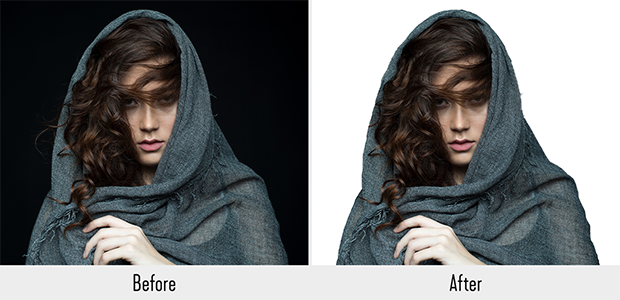How To Make A White Background Layer In Photoshop
How to Make a Background White in Photoshop
by Alexandra Bateman on Sep 15, 2022
Take you always taken what you recollect is the perfect photo on a white groundwork, only to observe that the white comes out gray in mail-production? It happens to the best of u.s., but yous tin can ready it past learning how to brand a background white in Photoshop!
While a plain white background might not seem important at starting time, it can be crucial for your wedding photography collections, website images and commercial photos. Afterwards all, an prototype with pure white edges fades well into well-nigh websites. And, white backgrounds are easy to make transparent for design projects!
Today, we're going to learn how to brand a background white in Photoshop, so that you don't have to waste product your otherwise perfect pics. Of form, you'll need Photoshop to follow along with this tutorial. If you don't have it nonetheless, you can get Photoshop from Adobe'due south site every bit part of their Creative Cloud Package with Lightroom.
Without further ado, let's leap into it. How can yous brand a background white on Photoshop?
In today'southward blog, nosotros'll expect at:
- Why you lot need a evidently white background
- Steps to make a background white in Photoshop with Levels Adjustments
- How to make a background white in Photoshop with Selection Tools
- How to test for pure white
Allow's get started.
Why You Demand a Plainly White Groundwork
There are many reasons why photographers may need to replace an object's background with a plain white space. For case, you might need to:
- Remove distractions: A pure white background tin can give your discipline more focus and help your clients look their best.
- Fix colour issues: The incorrect colors in a background can brand your subjects look pale and reduce the bear upon of your photos.
- Prepare photos for commercial use: Images with obviously white backgrounds can be used for all sorts of branding initiatives both online, in print and in other advertisements.
With so many uses for photos with white backgrounds, information technology's of import that yous larn how to edit them properly! Allow's take a look at the steps to making a background white in Photoshop.
Steps to Make a Background White in Photoshop
Every bit with well-nigh editing operations in Photoshop, there are a number of ways to make an image'due south background white. We'll focus on two of these editing techniques in this tutorial and test them both out on the same image.
The start pace in each approach is the same — getting your photograph into Photoshop. Here's how to import your image to Photoshop:
1. Open up Your Image in Photoshop
You'll first need to open up your image in Photoshop then that you can work on making the groundwork white. Simply right-click on your photograph, so select Open with… and choose Photoshop. Your photo volition open in a new Photoshop window on your screen.

Earlier we can begin making edits, we demand to duplicate the original paradigm layer. You could brand your edits on the original image layer, but then y'all run the risk of permanently irresolute the paradigm file. It's best practice to edit on a duplicate layer and then that the original layer remains intact.
To duplicate the epitome layer, choose Layer >> New >> Layer from the upper menu bar to create a new layer.

Or, click on the original layer in the Layers Console on the bottom right of the screen, then elevate the layer to the New Layer push. This button appears as a square post-it at the bottom of the Layers Panel.

One time you've duplicated the layer, you can rename it however yous choose. For the purposes of this tutorial, I'll name my duplicate layer "Edits," since it will incorporate all of my edits to make the image background white.

Brand a Groundwork White in Photoshop with Levels Adjustments
One of the ways to make a background plainly white in Photoshop is by adjusting the paradigm's color levels. This process is fairly simple for most images with unproblematic backgrounds.
By adjusting the color levels, we can desaturate the image so that the background turns white.
1. Adjust Levels Sliders
In social club to conform the levels, click Image in the top menu, then select Adjustments >> Levels.

Photoshop volition pull up an adjustments slider with three tabs, ane for each of the primary color channels. Adjust the Levels sliders until the background of the paradigm is plain white. For some images, this may hateful pulling all of the Levels sliders to 0.

Notation that adjusting these Levels sliders desaturates the unabridged image, not simply the background We'll remedy that problem in these next steps!
2. Add a Layer Mask
Now that we have an prototype with a white groundwork, we can create a Layer Mask to add the subject back into the photograph.
We'll duplicate our original image layer as we did at the beginning of the tutorial. Now, we need to reorder the layers in our Layers Panel then that the mask reveals our duplicate image layer.
We want the layer containing the edited white background, which we labeled "Edits," to sit between our original image layer and our duplicate image layer in the Layers panel. Your Layers Panel should look something like this:

Now, permit's add a Layer Mask to our topmost layer, the duplicate image layer. To add a layer mask, select the gray square icon with a circle in the middle, located at the bottom of the Layers Panel. Brand sure to select the topmost layer before you add your Layer Mask.

You'll know you've added a Layer Mask correctly when yous see a white layer attached to the indistinguishable image layer in the Layers Panel.

This mask will allow us to pigment out a portion of the indistinguishable paradigm layer in order to reveal the layer beneath it. In this case, the layer beneath is our desaturated prototype layer.
Select the Hard Round brush on the Photoshop Castor Tools Panel, or select B on your keyboard. Fix the opacity of your brush to 100%, using the opacity slider near the top of the Photoshop screen.

3. Paint Out the Background
With your difficult-round brush selected, change the color to black by clicking on the topmost square at the bottom left of the Tools Panel. Select the Layer Mask, and so start painting black onto the mask to reveal the white background.
Pigment out the background around your clients or subjects. Precision is important here, and so don't be afraid to reduce the size of your brush and zoom in closely. Also, know that you can build upwards the blackness on the layer mask by releasing and clicking again. This will let you to add together brightness and darkness as necessary to the groundwork.

The great matter about Layer Masks is that, if y'all make a mistake, you can repaint the portion of the image you lot erased by switching to white paint. Photoshop makes it easy to toggle back and forth betwixt white and black past pressing the X key on your keyboard.
A note: If y'all don't want to bargain with Adjustments and Levels sliders, you can accomplish the aforementioned effect by creating a new layer and filling it with white paint. This approach saves a few steps without sacrificing the quality of your edit.
Once you're finished painting in your white background, printing Cmd/Ctrl + South to save your progress.

Use Selection Tools to Make a Background White in Photoshop
The higher up approach is simple enough, only sometimes you need a more than precise edit to brand your white groundwork expect believable. There'due south a ton of room for error when working with Layer Masks and hand-painting out your image'south groundwork. Instead, permit's wait at another arroyo using Photoshop's born selection tools.
1. Mask the Background
One time you've imported your epitome to Photoshop, cull Select from the upper menu, then pick the Select and Mask option.

Next, in the upper correct-hand corner of the sidebar menu that opens, choose the driblet-downward to select a Viewing Way.

Photoshop'southward Viewing Modes volition help united states of america to see our edits against our original image equally nosotros brand them. For this tutorial, I've called to use the Overlay Viewing Mode. You'll notice that the Overlay style creates a red color bandage over the entire image.

2. Select the Image Subject
Next, we need to tell Photoshop who or what our image bailiwick is. To do that, we'll use the Quick Choice Tool to paint our subject in the photograph. Simply click on the Quick Selection Tool icon in the upper left of the Viewing Modes screen, then click and drag your cursor to select your field of study.

The Quick Pick Tool helps in this procedure by automatically selecting like pixels beyond an area. Because this tool uses AI to detect similar pixels, you'll want to use this arroyo on images where the subject stands out from the background, rather than ones where the subject blends in.
Afterward you lot've painted the bulk of your discipline with the Quick Selection Tool, use the Refine Edge Tool from the same left-hand sidebar to create sharper edges effectually your focal point. Remember, yous can zoom into our prototype to brand a closer selection, and yous tin can conform your brush tools within the Viewing Modes console.

When you've painted your subject selection and you lot're happy with the results, you're prepare to output your choice to the main Photoshop window. To do this, select Output To >> New Layer with Layer Mask from the lesser right of the screen.

This performance moves your image back to the Photoshop home screen in a new layer. This new layer has the background of the photograph masked out, which just leaves your subject remaining.

3. Add a White Background
At present that you've elminated the groundwork, you can add in a white background behind your bailiwick. Merely create a new layer by selecting Layer >> New >> Layer. Cull a patently white, and utilize the Fill up Tool to paint the layer white.
Motion this white layer underneath your masked prototype layer in the console to put your subject on a white background.

4. Touch on Up Your Work
At this step, you may notice that not all of your edges are crisp. That'south okay! Although it uses AI, the Quick Selection Tool isn't fool-proof. We tin can fix these edges pretty easily at this betoken in our editing process.
To further refine your edges, you lot can merely zoom into the photograph and pigment with a black brush onto the mask. That will erase the fringed edges of your photograph.
If that sounds as well tedious, yous tin choose to use the Defringe Tool instead. Navigate to the top menu, then select Layer >> Matting >> Defringe.

A dialog box will announced and enquire you to input a pixel value. This pixel value determines how many pixels Photoshop will remove from the edges of your subject. I used a x pixel value for my paradigm, just each photo will be unlike. Play effectually with the pixel value until you find ane that suits your edit.
Now, make sure to salve your progress!
four. Check Your Work
Regardless of the editing approach you chose, you'll need to brand sure that you've accomplished the effect y'all wanted. While your background may await white, it may not be completely white.
The easiest way to determine if your epitome background is obviously white is to create a new Threshold Adjustment Layer past choosing Layer >> New Adjustment Layer >> Threshold from the upper menu.

Click OK in the dialog box that appears. And so, move the Threshold slider all the way to the left. If y'all see whatsoever blackness remaining in the groundwork of your paradigm, then your groundwork isn't plain white!

If you notice a border between your epitome and the background in Photoshop, get into your menu and select Photoshop > Preferences > Interface. Click "None" for your border options on all of your layers to resolve the problem.
Here's our final result:

Making a Background White in Photoshop Has Never Been Easier
In that location y'all have it! Everything you need to know well-nigh how to make a groundwork white on Photoshop. With these skills, y'all'll be able to edit and adjust your images to perfection in no time!
For more than photography tips, editing tutorials and WordPress guides, follow the states on Facebook and Twitter. Make certain to sign up for our email list, too, and then you don't miss a single mail!
Using WordPress and want to become Envira Gallery free?
Envira Gallery helps photographers create cute photo and video galleries in merely a few clicks then that they can showcase and sell their work.
How To Make A White Background Layer In Photoshop,
Source: https://enviragallery.com/background-white-in-photoshop/#:~:text=Add%20a%20White%20Background&text=Simply%20create%20a%20new%20layer,subject%20on%20a%20white%20background.
Posted by: gardnerdahme1991.blogspot.com








0 Response to "How To Make A White Background Layer In Photoshop"
Post a Comment